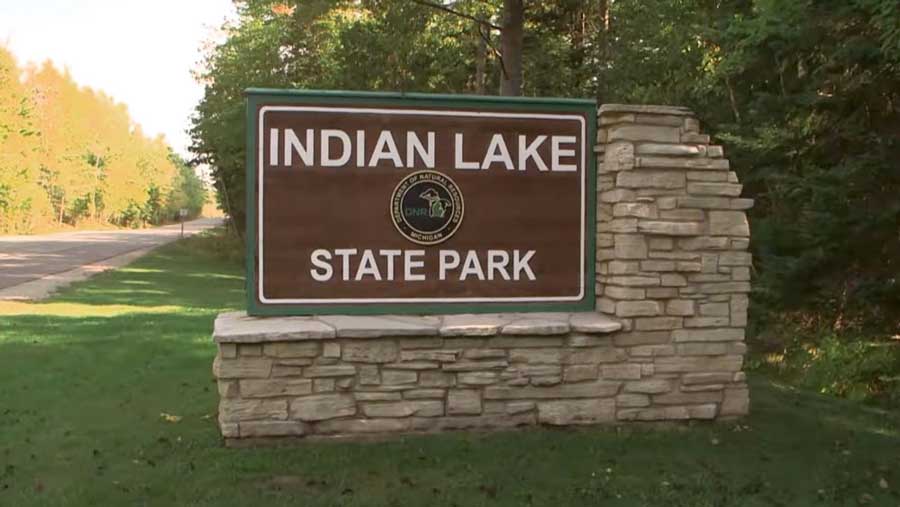 And there’s something truly magical and fun about the UP that makes us want to keep coming back. And for us, the official start of our UP trip starts when we’re crossing the Mighty Mack, the big bridge over the Mackinac Strait. It’s a fun drive, you’ve got great scenery out there, and when we cross the Big Mack, it means the Upper Peninsula magic is about to start.
And there’s something truly magical and fun about the UP that makes us want to keep coming back. And for us, the official start of our UP trip starts when we’re crossing the Mighty Mack, the big bridge over the Mackinac Strait. It’s a fun drive, you’ve got great scenery out there, and when we cross the Big Mack, it means the Upper Peninsula magic is about to start.
We reached Manistique a bit late, but we were in time to see the full moon rising near the city’s historic water tower. We headed to Indian Lake State Park for the night. Our home for this journey was a Jayco Melbourne motorhome, a compact rig that was just right for UP wandering and comfortable living. Easy access sites and the usual amenities made for a fast setup, and the adjacent Indian Lake was a gorgeous backdrop for the evening.
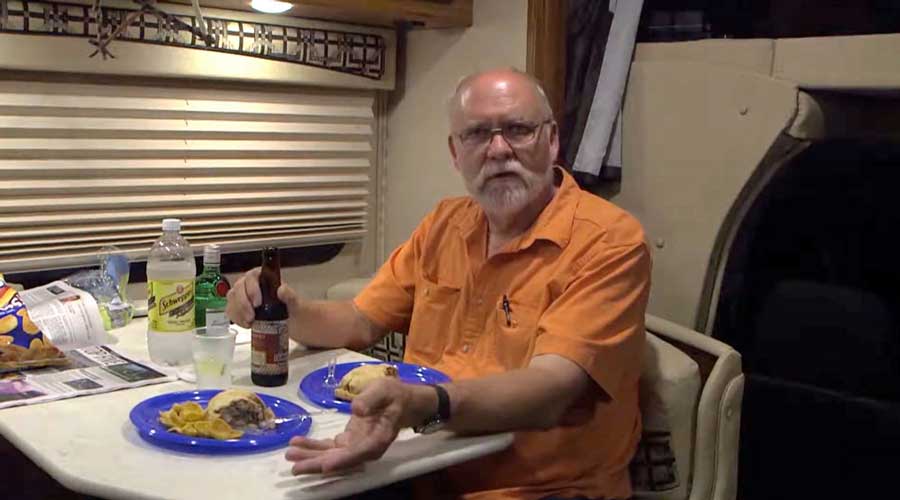 It’s our first night here in the UP. We’re at Indian Lake State Park in Manistique, Michigan. We arrived a little bit too late to cook outside, so naturally we stopped and picked something up along the way. And when you’re in the UP, the normal thing to pick up is pasties. Got a couple of pasties, local beer, Escanaba Black Beer, gin and tonic. So, it looks to me like we’re pretty well set for the night. It’s been a beautiful trip so far, sunny, cool weather, beautiful, little bit windy. Just the kind of day that really gets you fired up about visiting the UP.
It’s our first night here in the UP. We’re at Indian Lake State Park in Manistique, Michigan. We arrived a little bit too late to cook outside, so naturally we stopped and picked something up along the way. And when you’re in the UP, the normal thing to pick up is pasties. Got a couple of pasties, local beer, Escanaba Black Beer, gin and tonic. So, it looks to me like we’re pretty well set for the night. It’s been a beautiful trip so far, sunny, cool weather, beautiful, little bit windy. Just the kind of day that really gets you fired up about visiting the UP.
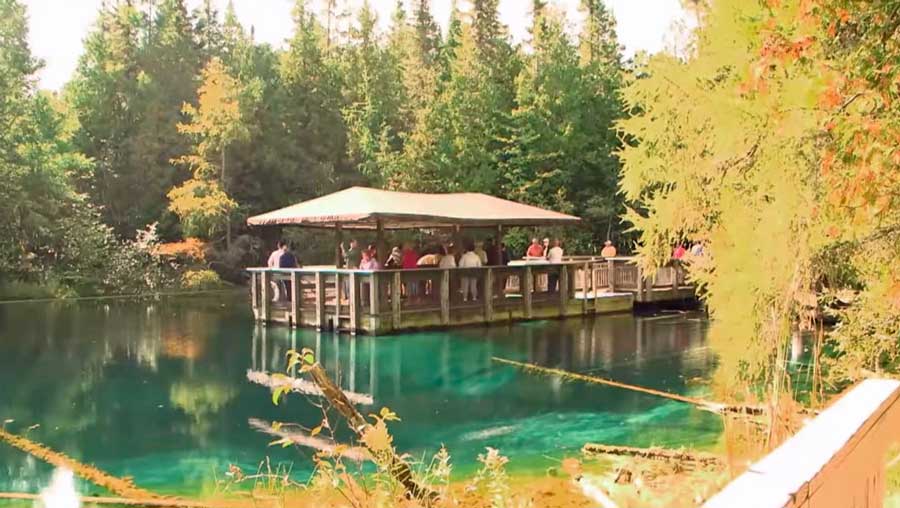 Our next destination is Kitch-iti-kipi Big Spring in Palms Book State Park near Manistique. Easy access RV parking is plentiful. This site is Michigan’s largest spring, and it’s a fascinating natural attraction. The tethered people-powered observation raft is designed for easy viewing of the features visible through the crystal clear water. This is a beautiful natural feature. With a raft, you go out on the springs, and you get to look down through this wonderful clear water and the fascinating geology and animal life down below. It’s a cool place to visit. More than 10,000 gallons of water per minute enter the pool through the limestone rocks below. The water remains at 45 degrees all year, so the spring never freezes, and the gushing water helps keep the sandy bottom in constant motion. Fat trout and ancient lime-encrusted trees and branches can also be seen in the crystal clear water. Kitch-iti-kipi is definitely worth the stop if Mantistique is in your UP agenda.
Our next destination is Kitch-iti-kipi Big Spring in Palms Book State Park near Manistique. Easy access RV parking is plentiful. This site is Michigan’s largest spring, and it’s a fascinating natural attraction. The tethered people-powered observation raft is designed for easy viewing of the features visible through the crystal clear water. This is a beautiful natural feature. With a raft, you go out on the springs, and you get to look down through this wonderful clear water and the fascinating geology and animal life down below. It’s a cool place to visit. More than 10,000 gallons of water per minute enter the pool through the limestone rocks below. The water remains at 45 degrees all year, so the spring never freezes, and the gushing water helps keep the sandy bottom in constant motion. Fat trout and ancient lime-encrusted trees and branches can also be seen in the crystal clear water. Kitch-iti-kipi is definitely worth the stop if Mantistique is in your UP agenda.
Next up was Fayette Historic State Park. This 1867 era town includes many restored buildings and historic displays that help a visitor envision life in an early day iron smelting community.
Aaron Thill: Fayette State Park is an iron smelting village. In its heyday, it was in operation from 1867 to 1891, and there was 500 residents in and around Fayette. We encompass 711 acres. They made pig iron.
They shipped in iron ore from Negaunee by rail to Escanaba, and then it was shipped by–shipped over to Escanaba, to Fayette with the abundance of hardwood on the peninsula that was brought in from locally, and made pig iron, and then that was shipped out to the Great Lakes. The hardwood was used to make the charcoal to fire–to fire the blast furnaces. Today, one of the kilns still stands in the park. The rest of them, you can see the ruins of some of them. And then on the peninsula, there’s different sites where you can still see the ruins of old kilns. A lot of the buildings still stand today, and they’ve got displays set up in them where you can walk into them and see how they lived back in that day. The hotel, the bottom floor of the hotel is open, the superintendent’s house. Most of the buildings today still stand.
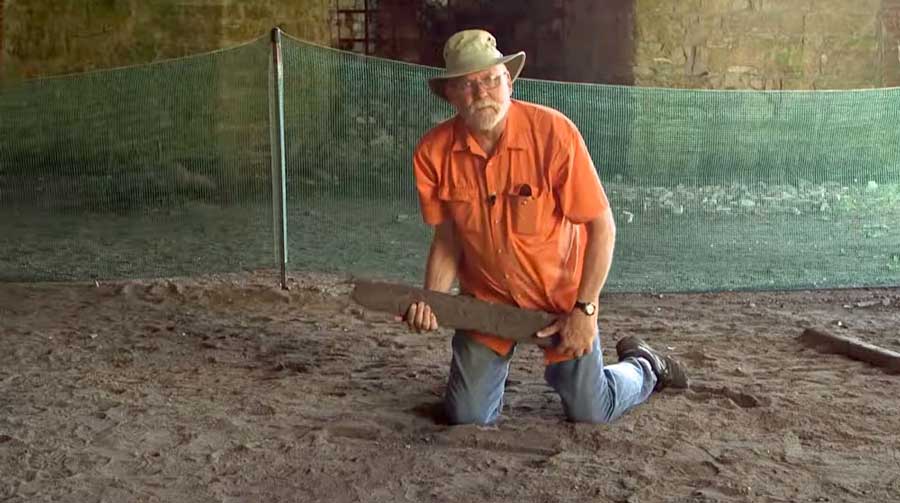 Jeff: This is one of the casting rooms here at Fayette Park. The iron ore was drawn out of the furnaces, ran down through troughs in the floor, and cast into pig iron. It was then shipped out for later use. Pig iron very much like this guy here, oof. They weigh–some were over 100 pounds apiece. All day long casting these guys and shipping them out, life was not easy here at Fayette Park back in those days. Between the brutal winters and dangerous working conditions, well, it’s what you did to make a living, I guess, and to make the pig iron that helped to build the country. Fayette State Historic Park is one of those wonderful places where the preservation efforts of all concerned, combined with the presence of all these fantastic original structures, helps to bring a little bit of Michigan history to life.
Jeff: This is one of the casting rooms here at Fayette Park. The iron ore was drawn out of the furnaces, ran down through troughs in the floor, and cast into pig iron. It was then shipped out for later use. Pig iron very much like this guy here, oof. They weigh–some were over 100 pounds apiece. All day long casting these guys and shipping them out, life was not easy here at Fayette Park back in those days. Between the brutal winters and dangerous working conditions, well, it’s what you did to make a living, I guess, and to make the pig iron that helped to build the country. Fayette State Historic Park is one of those wonderful places where the preservation efforts of all concerned, combined with the presence of all these fantastic original structures, helps to bring a little bit of Michigan history to life.
Fayette State Park Campground is just a few miles south of the historic park, and a great place to camp when touring the area. This is kind of off the beaten path, but it’s easy to find places like this. Next, we head north to the crossroads town of Shingleton, and stop by a small family run company building a classic product that’s well suited to the north country.
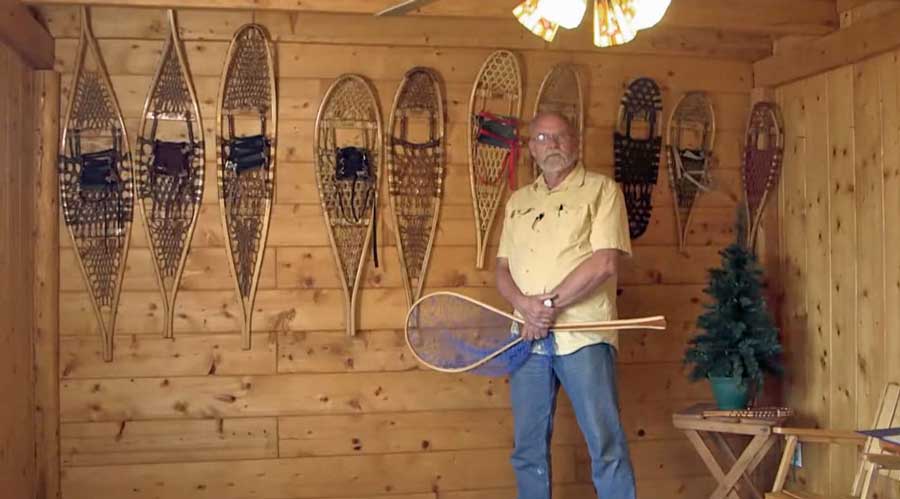 Winter sports and winter recreation are really important here in the UP. After all, they have an awful lot of winter up here. We’re going to be paying a visit here to a company whose products help to support winter sports. It’s Iverson Snowshoe Company. And what makes them unique is that they do things the old fashioned way. They build their snowshoes entirely in the US out of locally sourced products. And their craftsmanship and the way the products look, it kind of harkens back to a different time in winter recreation.
Winter sports and winter recreation are really important here in the UP. After all, they have an awful lot of winter up here. We’re going to be paying a visit here to a company whose products help to support winter sports. It’s Iverson Snowshoe Company. And what makes them unique is that they do things the old fashioned way. They build their snowshoes entirely in the US out of locally sourced products. And their craftsmanship and the way the products look, it kind of harkens back to a different time in winter recreation.
Here in the showroom, they have a little bit of a display, so you can take a look and see what kind of products they make. They have over 22 different styles of snowshoes typically made out of rawhide or neoprene, made with a white ash wood frame. And they also have really nice looking, very artistic fishnets. The factory isn’t running yet here at Iverson, but they’ve still got a little bit of stock backed up for when they can get started. This one is called a 10 by 36 Green Mountain. It’s been bent, it’s made out of the bent white ash which they steam in order to bend like this, and it still has to be laced up and so on, but it’s well on its way to becoming another pair of classic Iverson snowshoes. Look for these at L.L. Bean, sporting good retailers, and so on nationwide.
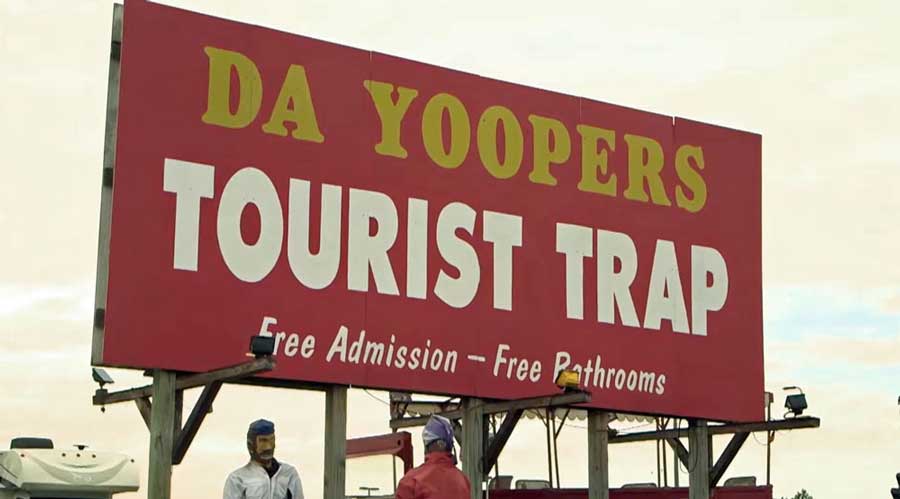 Tourism is a very important industry here in the UP. There’s all kinds of tourist destinations, some would say tourist traps. But there is in fact only one genuine tourist trap here in the UP.
Tourism is a very important industry here in the UP. There’s all kinds of tourist destinations, some would say tourist traps. But there is in fact only one genuine tourist trap here in the UP.
The Da Yoopers Tourist Trap was started by Jim Hoolie deCaire, the head guy at the Yoopers comedy and music group.
Jim deCaire: Well, you know, I always–I always got a kick out of when I travelled on the road and stuff. We’d go to a lot of rock and mineral shows all over the country and stuff, and do buying for our store. And we’re traveling back in the 70s, when all the hippies were out there on the road, and you know, so we saw a lot of–you know, we stopped to see the world’s largest ball of twine and the plastic dinosaur, and so does everybody else. You know, so I said, “Well, you know, that would be kind of–we have to have something here. Not only a store with gifts, but something to look at.” I was so impressed with Wall Drugs, you know, with the signs and all that, and along the highway, and I’m thinking, “Yeah, you know, people come travel, they want to stop.” So, we advertised free admission and free bathrooms. And the free bathroom thing is important. It may be a joke, but it’s important. People would say, “Who created all this stuff? This is just wonderful.” I said, “A D student created all this because an A student could never think of the stuff like this.” And I was the guy in the back of the class that was doing all the bird calls. So, I had nothing else to do but think about this stuff. So, we started, and then some people started bringing in stuff. “Oh, this was my father’s, he just loved this. You know, it’d be so nice if you put his name on it.” So, when they have people coming up, they take them here to see their father’s sculptures or their father’s–I think someone–it’s kind of cool to have people come here and thank you, you know. And I’m thanking them. “Well, thanks for thinking about us.”


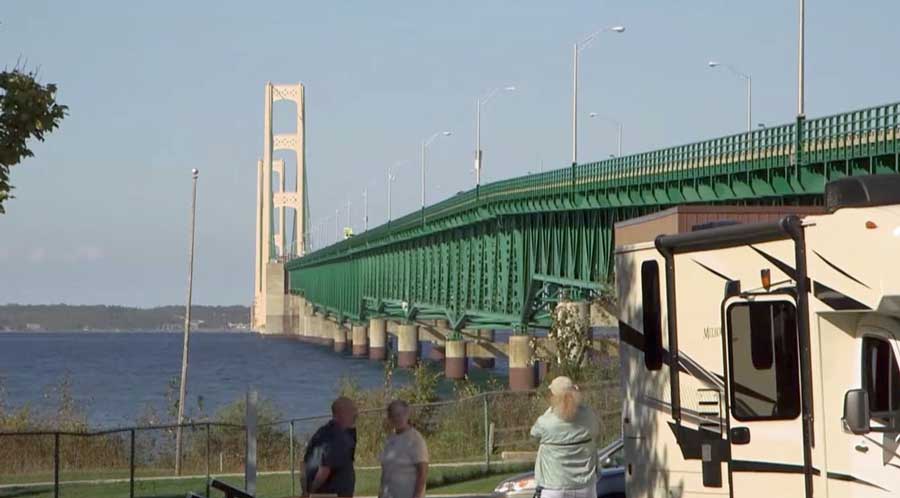


 Our next destination is
Our next destination is 
 Winter sports and winter recreation are really important here in the UP. After all, they have an awful lot of winter up here. We’re going to be paying a visit here to a company whose products help to support winter sports. It’s Iverson Snowshoe Company. And what makes them unique is that they do things the old fashioned way. They build their snowshoes entirely in the US out of locally sourced products. And their craftsmanship and the way the products look, it kind of harkens back to a different time in winter recreation.
Winter sports and winter recreation are really important here in the UP. After all, they have an awful lot of winter up here. We’re going to be paying a visit here to a company whose products help to support winter sports. It’s Iverson Snowshoe Company. And what makes them unique is that they do things the old fashioned way. They build their snowshoes entirely in the US out of locally sourced products. And their craftsmanship and the way the products look, it kind of harkens back to a different time in winter recreation.